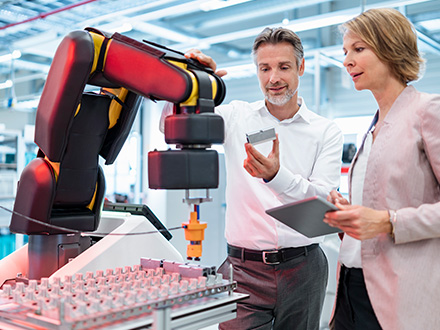Your 9 Most-Asked Smart Manufacturing Questions (and Answers)
Whether you've already introduced components of smart manufacturing to your organization or are still assessing the value and future benefits against the resource commitment, understanding smart manufacturing's capabilities is crucial to realizing its full potential.What Is Smart Manufacturing?
We are experiencing a level of work transformation seen just a few times in the past 300 years. Many experts are defining the current era as Industry 4.0 ' a fourth phase of the Industrial Revolution, following mechanical innovations of the 18th century, electric-powered mass production in factories and the introduction of computers and robots to the workplace. That brings us to the fourth: the introduction of big data to industry. By working with solution providers to implement artificial intelligence (AI), Industrial Internet of Things (IIoT), robotics, monitoring and more, organizations across industries are implementing solutions that are not only revolutionary, they're custom-designed to the unique needs of the verticals. Consider a real-world, recent example of smart manufacturing in action. An Automation World piece spotlighted the use of AI for identifying common defects in the welding process in its factories. With early detection of porosity defects ' essentially cavities in the metal created during the cooling process ' John Deere avoids much more costly and time-consuming issues later in the manufacturing process. Smart manufacturing takes data and tools to improve efficiencies and outcomes for people and organizations.What Role Does Data Play in Smart Manufacturing?
To understand the implications and potential uses of smart manufacturing technologies, first, we need to look at big data. IBM defines big data as 'data sets whose size or type is beyond the ability of traditional relational databases to capture, manage and process the data with low latency. Characteristics of big data include high volume, high velocity and high variety.' Common techniques in the exploitation of big data include data mining, text analytics, predictive analytics, data visualization, AI, machine learning, statistics and natural language processing. All of these are elements that contribute to a changing industrial environment. So, big data is the firehose that, without strategic control and thoughtful interpretation, has limited use as a tool. But this wealth of data and its applications can be harnessed, along with machine learning, to shift the burden of monitoring and reporting system information to computer resources rather than human ones. With a reduced risk of error, this shift in responsibility frees up staff hours for working with the insights generated by the data, not manipulating the raw data itself. In Automation World, author John Clemons wrote about the transformation of raw data into usable insights: 'Ultimately, the data needs to be visual, through human-machine interfaces and dashboards. This allows people, whether plant floor machine operators or executives, to use data in real time. Making data actionable applies as much to not getting the data you don't need.' The data holds the promise. Implementing the right tools and forming the right partnerships to use the data is where smart manufacturing delivers.How Much Does It Cost To Implement a Smart Manufacturing Strategy?
The promise of smart manufacturing is one few companies can afford to refuse. Unlocking the benefits and value of smart solutions in manufacturing requires leaping the hurdle of set-up costs and transition. The good news is, much of the useful data may already exist but simply need to be harnessed and integrated with new or additional sources into user-friendly interfaces to generate strategic insights. The nonprofit SME suggested five steps to maximize ROI from smart manufacturing:- Collect data from a diverse ecosystem of connected equipment. Use existing data or retrofit machinery to generate data.
- Prepare data by converting it into actionable formats. Ensure data is consistent, accessible and understandable for human use.
- Process data by creating secondary measures.
- Monitor data for anomalies. Working in real-time ensures actions can be taken before major issues develop.
- Conduct analytics to correlate outcomes with anomalies.
- With thoughtful implementation, ROI on new technologies can continue to justify the initial outlay.
Supply Chain Risk Management: How to Identify and Mitigate Threats
Is Artificial Intelligence on the Rise or on the Way Out?
AI's numbers suggest it is going nowhere but up. Consider the field of robotics. In its Artificial Intelligence In Robotics Market Outlook 2021, Shotcaller.com includes the prediction of compound annual growth rate of 28% leading into 2025. It also notes the unequaled growth in the Asia Pacific region, which is 'expected to dominate the market in terms of the deployment of industrial robots in the manufacturing sector to enhance productivity. For instance, according to IFR World Robotics, Asia accounted for 69.1% of industrial robot shipments in 2018. Europe accounted for 17.2%, and the United States accounted for 13.7%.'How Is Automation Used in Smart Manufacturing?
Automation has had a role in manufacturing since the advent of the Industrial Revolution, a symbiotic relationship that moved through assembly lines to factory robotics. In the Industry 4.0 era, automation has taken on an enhanced role ' particularly with the early days of COVID-19 response behind us. The days ' then weeks and months ' of unpredictable work stoppages and changing guidance created uncertainty around many organizations' available resources. Automation doesn't replace human capital, but it can replace some of the unpredictabilities related to staffing, skill deficits and, of course, human error. Encompassing but not limited to robotics, automation covers every aspect of factory and C-suite functions that systems rather than humans perform. So automation is all about increasing speed, efficiency and actionability. After all, quantities of data have moved through the factory floor and the C-suite for as long as they've existed. But being able to glean insights instantly and take strategic action has often been limited to moments of educated guesswork. That's no longer the case.What Is the Future of Blockchain Within Manufacturing?
The efficiencies brought to the industry by smart manufacturing can be seen in the potential of blockchain. Defined as a digital database containing information (such as records of financial transactions) that can be simultaneously used and shared within a large decentralized, publicly accessible network, blockchain is also the technology that makes cryptocurrencies such as Bitcoin possible. Consider this observation from the Harvard Business Review piece, The Truth About Blockchain: 'With blockchain, we can imagine a world in which contracts are embedded in digital code and stored in transparent, shared databases, where they are protected from deletion, tampering and revision. In this world every agreement, every process, every task and every payment would have a digital record and signature that could be identified, validated, stored and shared. Intermediaries like lawyers, brokers and bankers might no longer be necessary. Individuals, organizations, machines and algorithms would freely transact and interact with one another with little friction. This is the immense potential of blockchain.' Related to manufacturing, blockchain has promise. For example, blockchain could be a useful tool to identify copycat parts, HP then-Chief Technology Officer Shane Wall noted. In Blockchain in the Factory of the Future, the authors cite others, including protecting intellectual property and safeguarding and simplifying quality checks. For example: 'Aircraft manufacturers are testing the use of blockchain applications to track the provenance of aircraft components, which existing technologies struggle to do because aircraft production requires a multitude of parts produced by different suppliers. Manufacturers can use blockchain to prove the origin of parts and to verify that the parts meet the appropriate specifications.'Understand and Simplify Regulatory Compliance in Manufacturing
What Are the Benefits of IIoT and What Organizations Can Implement It?
Virtually every purchase decision for a home today comes with a decision of whether to opt for an IoT device. Just as a homeowner can gain peace of mind and greater control over their home's safety with IoT technology, business leaders and teams can reap the benefits of Industry IoT in their organizations. By connecting computer systems and devices within a factory or corporate setting or across sites, organizations can maintain a level of data security that is becoming more difficult to come by while improving speed and efficiency in information-sharing. In addition to many other benefits, organizations can improve predictive maintenance plans. Cited in The Ultimate Guide to Industrial IoT for Manufacturers: 'This allows manufacturers to take preventative measures against the issues before they occur, ultimately resulting in higher machine uptime and greater overall productivity. Preventing equipment failures reduces process time, rework, scrap and unplanned downtime. These improvements help manufacturers save on associated costs.'Are Industrial Robotics Important In 2021?
Robotics has a long association with manufacturing, and that doesn't look to change going forward. The reasons go beyond controlling costs. Consider Thailand as an example. From a Bangkok Post article titled Rise of the Robotics, 'Finding skilled workers has become a top challenge for manufacturing executives, and the shortage is unlikely to ease anytime soon. The most recent skills gap study from Deloitte and The Manufacturing Institute projects that over half of the 4.6 million manufacturing jobs created over the next decade will go unfilled.' It's not just a skills gap. Rising wages also play a role, as does an aging population. In Thailand, the working population is 'expected to decline by as much as 26% (from current levels) by the year 2050,' Mitsubishi President and CEO Morikazu Chokkisaid. 'Using robots helps minimize errors in the production process. This is quite a contrast to the job carried out by human workers. As a result, we foresee a significant increase in the use of automation and robots in the future.'What Are Digital Twins ' and What Is the Benefit?
In manufacturing, digital twinning is one of the most important innovations of the last two decades. The term itself was coined by NASA technologist John Vickers around 2000 and proposed as a manufacturing tool by Michael Grieves, chief scientist for advanced manufacturing at the Florida Institute of Technology. Think of a digital twin as a virtual blueprint fed by data ' comprehensive data updated in real-time and presented in a user-friendly visual interface that enhances and speeds diagnoses, performance predictions and decision-making. In Grieves' 2014 white paper, Digital Twin: Manufacturing Excellence through Virtual Factory Replication, he concluded:Focusing on the connection between the physical product and the virtual product enables us to conceptualize, compare and collaborate. We can conceptualize visually the actual manufacturing processes. We can compare the formation of the physical product to the virtual product in order to ensure that what we are producing is what we wanted to produce. Finally we can collaborate with others in our organization and even throughout the supply chain to have up-to-the-minute knowledge of the products that we are producing. Focusing on this connection between the physical product and the virtual product will improve productivity, uniformity of production, and ensure the highest quality products.In a late 2020 Gartner survey, 31% of respondents said that they use digital twins to improve their employee or customer safety as a result of COVID-19.
Key Smart Manufacturing Takeaways and Next Steps
'Most people are convinced we're in the midst of the fourth industrial revolution, but the story of the revolution is still being written. We're barely in the first chapter. That means the size and the impact of the fourth industrial revolution are still up to us. The challenge is to add even more power to the revolution to ensure that its impact is global, substantial and long-lasting.' ' John Clemons, The Challenges of Smart Manufacturing Introducing and enhancing technology as a decision-making and productivity-increasing asset is a must for any organization. But how you implement it and the partners you choose for your journey will directly impact the benefits you reap. Data security and a centralized system for collecting and storing data is paramount for smart manufacturing. Diligent's Modern Governance Platform provides a robust cybersecurity infrastructure along with a seamless operations framework that enables efficient collaboration, communication and workflows.





